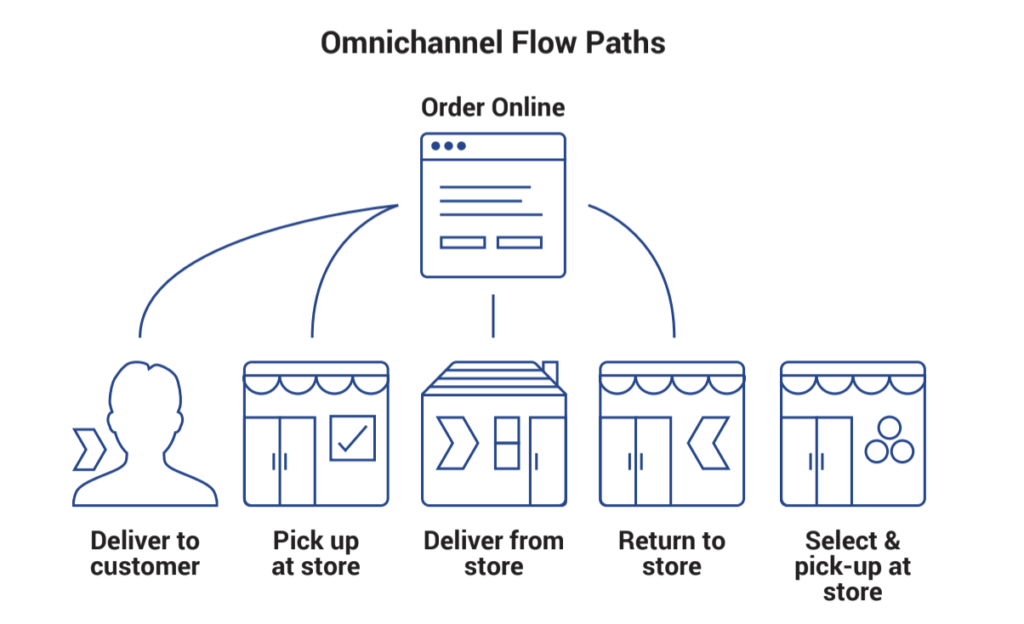Logistics managers are feeling the increasing pressures presented by rising demand in e-commerce and customer expectations of omnichannel fulfillment. Managers of Warehouses and Distribution Centers (DCs) are battling smaller orders, ever-decreasing delivery windows, and persistent labor shortages. A robust omnichannel logistics strategy can help improve transit times, lower costs and ensure the customer has a seamless experience.
What is Omnichannel Fulfillment?
Omnichannel fulfillment is an integrated approach to providing customers with a consistent shopping experience across channels. Consumers today buy in various ways, and from a large variety of platforms, leading to a vast number of permutations that need to be taken into account. Channels are any way you get your product into your customer’s hands, from warehouse fulfillment to in-store product pick-ups, or home delivery.

“Many shippers and 3PLs are still struggling to create a true, omnichannel retailing experience, as just 4% of shippers and 3% of 3PLs rated themselves as high-performing in omnichannel retailing in 2019; 4% of shippers and 14% of 3PLs rated themselves as efficient; 38% of shippers and 28% of 3PLs said they are inconsistent; 36% of shippers and 31% of 3PLs said they have no capability; and 18% of shippers and 24% of 3PLs rated themselves as competent.” Korn Ferry 2019 3PL Study
Types of Omnichannel Fulfillment Strategies
Warehouse Fulfillment
Warehouse fulfillment is when you lease or own a warehouse facility and ship orders directly from that location. A growing number of warehouse providers allow you to lease out only the space that you need. However, this can lead to time-consuming and costly issues with space and inventory management fluctuations. The costs of inventory storage and shipping can sometimes outweigh the value that you get from this approach.
Store Fulfillment
Businesses with brick-and-mortar locations may be able to keep stock within the store until it needs to be shipped. This use of a physical location as an order fulfillment hub can be a useful option for smaller businesses.
This approach can be advantageous for some. It can also be challenging for retail stores that do not have the systems, storage space and equipment to operate the same way a dedicated fulfillment center would. Access to real-time stock levels and returns management can be a challenge without the right set up.
3PL Fulfillment
Third-party logistics (3PL) providers help cover almost every aspect of omnichannel fulfillment. Once a customer places an order, your 3PL partner fulfills it.
With a robust 3PL partner, you should expect proof of delivery reporting (POD), inbound/ returns management, project management and documented standard operating procedures (SOP). This will allow you to focus on your core business and give you the peace of mind that you’re providing customers with a seamless experience.
The Importance of an Omnichannel Fulfillment Strategy
Maintain Visibility of Your Inventory
Having real-time visibility of your SKUs’ location helps you decide where to place inventory and how best to fulfill specific orders. If using a 3PL partner, ensure you have thoroughly tested their inventory management system (IMS) and be sure you can easily have end-to-end visibility to all of your products. Lastly, ensure you know how often the IMS is updated.
Flexibility and Scale
When choosing a 3PL partner, it is vital to ensure they can handle unanticipated spikes without significant increases in delivery times or costs. Responding to any seasonal or unforeseeable demand is crucial to delivering an omnichannel strategy.
Fulfillment is a critical piece in your customer’s journey and retention. Does your 3PL partner have the ability to scale with your business? Can they help you split your inventory as your demand increases across shipping zones? This is critical for brands trying to keep up with the two-day shipping expectations consumers now have.
Building Brand Equity
Brand equity is the commercial value derived from consumer perception of the brand name of a particular product or service, rather than from the product or service itself. By providing your customers with a seamless experience, you can build your brand equity by providing a seamless experience in line with today’s customer expectations.
Pre-Kit Orders Involving Multiple SKUs for Efficiency
For direct-to-consumer (DTC), often the same SKUs are ordered at the same time. A smart warehouse management system (WMS) will alert you to these trends, allowing you to efficiently pre-build most of the order. For example, say two haircare products are always ordered together, along with another SKU. Rather than picking three items every time, you can pre-pick and box the two popular SKUs, so your team is only doing one pick to complete the order.
More Accurate Reporting & Transparency
Gain access to instant reporting when you work with a 3PL partner to oversee all of your channels. This will help you identify your most important channels, predict future needs and highlight areas for improvement. The right provider should be upfront and transparent about any future events that may cause delays. Perhaps the president is coming to Los Angeles, where your fulfillment hub is. The road closures could lead to delays in shipments and you should be aware of that. Or vendors should be upfront how any upcoming blizzards may cause delays and communicate any changes they are making to try and meet their delivery schedules.
Challenges for Implementing an Omnichannel Strategy
Infrastructure is key. Not having the right infrastructure can be a hurdle for fully implementing omnichannel fulfillment. Whether you are a B2B or B2C business, it is essential to choose the right 3PL partner for your business. Managing bulk distribution for B2B fulfillment versus pick and pack for B2C requires different expertise. Ask about experience with accounts similar to yours, so you understand how they will manage your business.
Don’t settle for an off the shelf technology solution that can’t be agile to meet your company’s needs. The right vendor should provide a solution that works for you, rather than you have to adjust to meet their needs.
The Bottom Line
Omnichannel fulfillment is more than the latest buzzwords and industry jargon. It’s a strategy that puts the customer experience at the forefront of your supply chain, enabling you to grow and retain your customer base. Having transparency, real-time visibility, accurate reporting and flexibility will help you succeed.
Sources:
https://www.investopedia.com/terms/b/brandequity.asp
https://en.wikipedia.org/wiki/Omnichannel_order_fulfillment
https://www.kornferry.com/content/dam/kornferry/docs/article-migration/2019-3PL-Study.pdf

